“... Having clasped each other, they merged into the First Lightning, the Heavenly Serpent and the Sun Goddess. Happily rumbling, they descended to the First Earth, causing up and down themselves. Snakes created the world, and with it, Ioin, who created people, gave them crafts and the ability to survive. Later, when the children of Aoyna in large numbers settled around the world, one of them - the king of the country, Pan - wished to marry his own daughter. There was no one around who would not be afraid to go against the will of the lord. In desperation, the princess escaped with her beloved dog for the Great Sea. There, on the far shore, children were born to her. It was from them that the people who called themselves went Aynaswhich means - "Real people."
Aynas - The oldest population of the Japanese islands. The Ainu called themselves different tribal names - "soy-untara", "chuv-untara", and the name "Ainu" or "Ainu", which they used to call them, is not at all the self-name of this nation, it means only - "man" , "real man". The Japanese called the Ainu the word "emisi" or "ebisu", which in Ainu means "sword" or "people of the sword."
The Ainus also lived on the territory of Russia - in the lower reaches of the Amur, in the south of Kamchatka, Sakhalin and the Kuril Islands.
But at present, the Ainu remained mostly only in Japan, and according to official data, their number in Japan is 25,000, but according to unofficial statistics, it can reach 200,000 people.
In Russia, following the 2010 census, 109 Ainu were recorded, of which 94- in the Kamchatka region.
Origin
The origin of the Ainu and currently remains unclear. The Europeans, faced only with the Ainu in the 17th century, were amazed by their appearance - unlike the usual people of the Mongoloid race, the epicantus (the “Mongolian” fold of the century), the sparse facial hair, the Ainu had a European face phenotype, and besides - unusually thick and long hair on the head, wore huge beards (often reaching the waist) and mustaches (they had to be held with special chopsticks while eating). Despite living in a fairly temperate climate, in the summer the Ainu wore only loincloths, like residents of equatorial countries.
Currently, among anthropologists and ethnographers there are many hypotheses about the origin of the Ainu, which in general can be divided into three groups:
- The Ainu are related to the Indo-Europeans (the Caucasian race), according to the theory of J. Bachelor and S. Murayama.
- The Aines are related to the Austronesians and came to the Japanese islands from the south - this theory was advanced by the Soviet ethnographer L. Ya. Sternberg and it was she who dominated Soviet ethnography.
- The Ainu are related to the Paleo-Asiatic peoples and came to the Japanese islands from the north of Siberia, such is the point of view of most Japanese anthropologists.
Japanese colonists swiftly settled the island of Hokkaido, where the Ainu mostly lived, and in 1903 the population of Hokkaido consisted of 845,000 Japanese and only 18,000 Ainu.
Thus began the period of the most cruel Japaneseization of the Ainu of Hokkaido.
It should be noted that on Sakhalin and the Kuril Islands, where the Russians were, the Ainu people were very much to them - many Ainu had a command of the Russian language and were Orthodox.
The Russian colonial order, despite the many abuses of the yasak collectors and the armed conflicts provoked by the Cossacks, were much softer than the Japanese. In addition, the Ainu lived in their traditional environment, they were not forced to radically change their way of life, and were not reduced to the position of slaves. They lived in the same place where they lived before the arrival of the Russians and were engaged in traditional hunting and sea fishing.
However, in 1875, all of Sakhalin was assigned to Russia, and all the Kuril Islands were transferred to Japan.
An ethnic catastrophe occurred - the Japanese transported all the Ainu from the Northern Kuriles to Shikotan Island, took all their fishing gear and boats from them and forbade them to go to sea without permission. Instead of traditional hunting and fishing, the Ainu were attracted to various hard work for which they received rice, vegetables, some fish and sake, which absolutely did not correspond to their traditional diet, which consisted of meat of sea animals and fish. In addition, the Kuril Ainu were on Shikotan in conditions of unnatural overcrowding. The consequences of ethnocide were not long in coming - many Ainu people died in the very first year.
The terrible fate of the Kuril Ainu very soon became known to the Japanese and foreign public and the reservation was liquidated, and the surviving Ainu, only about 20 people sick and impoverished, were taken to Hokkaido. Even in the 70s of the twentieth century there were data on 17 Kuril Ainu, however, how many of them came from Shikotan is still unclear.
The Russian administration of Sakhalin was mainly engaged in the northern part of the island, giving the southern part to the arbitrariness of Japanese industrialists, who, realizing that their stay on the island would be short, sought to exploit its natural resources as much as possible and brutally exploiting the Ainu.
And after the Russian-Japanese war, when southern Sakhalin turned into the governorate of Karafuto and became intensively settled by the Japanese, the new population exceeded the Ainu many times.
In 1914, the Japanese authorities gathered all Ainu Karafuto in ten settlements, restricted their movement around the island, struggled in every way with traditional culture, traditional Ainu beliefs, and tried to make the Ainu live in Japanese.
And in 1933 all the Ainu "turned" into Japanese subjects, assigned Japanese names, and the younger generation later received Japanese names.
After the Soviet-Japanese war of 1945 and the surrender of Japan, most of the Ainu Sakhalin and the Kuriles, together with the Japanese, were evicted (and partly also voluntarily emigrated) to Japan.
On February 7, 1953, authorized by the Council of Ministers of the USSR for the protection of military and state secrets in press, K. Omelchenko, in a secret order, indicated to the heads of departments of the USSR Glavlit (censors): "It is forbidden to publish any information about the Ainu people in the USSR in the press". This ban existed until the early 1970s, when the publication of Ainu folklore was resumed.
Modern Ainualthough recognized by the Japanese parliament on June 6, 2008 independent national minority, completely assimilated and almost indistinguishable from the Japanesethey often know much less about their culture than Japanese anthropologists, and they don’t seek to support it, which is explained by the long-term discrimination of the Ainu by the Japanese.
Currently, the Ainu culture in Japan is fully placed at the service of tourism and, in fact, is a type of theater, and the Japanese, and the Ainu themselves cultivate "exotic" only for tourists.
A.A. Kazdim
Academician of the International Academy of Sciences
Ecology and Life Safety, a member of MOIP
Perhaps the oldest semantic type of ethnonyms - with the meaning of "people", with the opposition "their - others".
Source: Postcard, France
In the modern world, according to various estimates, there are three or four thousand ethnic communities — from micro tribes of several hundred (and even dozens) people to peoples numbering many tens and hundreds of millions of people. The uncertainty of the number is explained by the different approaches of the researchers to the problem “ethnos, subethnos, ethnographic group”. There are ethnologists who consider Sardinians to be a separate people, others see them as a subethnos of Italians. Or, say, the Welsh (Welsh) - a special people or ethnographic group of the British?
Self - "people"
Ethnonyms (from the Greek. Ethnos - the tribe, the people and onyma - the name), the names of ethnic communities - several times more. Firstly, there are many ethnic groups that have more than one self-name (endo-ethnonym). Secondly, there are even more exoethnonyms (names that their close and distant neighbors gave to the peoples). And then there are thousands of names of the tribes and peoples of past eras, recorded in written monuments, place names and other sources.
Most of the ethnonyms took shape in ancient times, many in primitive antiquity. The emergence of the ethnonym self-name is an extremely important step in the development of community. This meant that its members realized their group as a special cultural and linguistic unity, with a common origin for all of them, and distinguishing it from all other communities.
Several generations of researchers of various specialties (in many countries, not only in Russia) were engaged in and are engaged in the ethnonym "Russia", "Russians"; There is a very large literature on this topic, but the etymology of the term still remains problematic (there are many hypotheses, a satisfactory, convincing solution that one would make - if not all, but most experts do not). To a large extent, it seems, because purely philological studies here are complicated by the historical and political problem of the origin of the old Russian statehood.
Perhaps the most ancient semantic type of ethnonyms is self-designation with the meaning “people”, with the opposition “ours are aliens”. There are a lot of them, most of them from that remote era when people lived in closed, isolated groups (clans, tribes). In the minds of each such group, humanity was divided into two parts: their own (“people”) and all the rest (non-people, nonhumans).
Actually, the words "man", "people" (variants "own, own"; "real people") in different languages, in different "corners" of the ecumene were the first self-names of human groups. In many nations, they have survived to the present day (or can be traced with in-depth linguistic analysis). The self-name of the Siberian peoples of the Nenets, Khanty, Mansi, Nganasans, Nanai - is the same (translated from their languages): “person”. The Mari self-name (Mari, Mari) is “man”, “man”. The ancient ethnonym Komi-murt ("man"); he entered into the self-name of his related Udmurts. North African Berbers, Eskimos in the far north of America and Guajiro in Colombia, the people of Yao (in China and Vietnam) and the Attacks (in the United States and Canada) call themselves the same - “people”.
Some groups were not satisfied with such a modest name and called themselves proudly - “real people”. This is how the self-name of a part of the Chukchi, one of the groups of the Nenets, is translated; so call themselves Indians Dakota and Indians Delaware. South African Hottentots asserted themselves, calling themselves “koi-koin”, “human people” (if “lowering the tonality”, the same thing would be: “real, true people”).
And if you thoroughly delve into the historical semantics and etymology of the Germans self-name (deutsch), it turns out that it goes back to the old Germanic words diot, diota and even earlier teuta ("people", "people"); hence, by the way, the Latin designation of the Germans - teutones, "Teutones".
And the ethnonym of Swedes leads its history from deep antiquity: it is raised to the Old High German word gi-swio, “brother-in-law” (“his people”, “his people”), suiones in Tacitus. "Svayami" Slavic tribes called them.
Cossacks and Kazakhs
Among the most ancient ethnonyms of the primitive communal epoch there are numerous names that signify the totem of this community. These are most often animals (bear, wolf, fox, etc.), but also plants, natural elements, etc. Dozens of ethnonyms of Indian tribes in all regions of America are formed from totems. So, let's say, the self-name of the Cheyenne Indians - "snakes". But the ethnonym of the Naga people in Burma (now Myanmar) has the same totemic meaning. A variety of totem names had (or still retain) many ethnic communities (and / or their divisions) in Siberia, in Southeast Asia, among Australian Aborigines and in other regions of the world.
There are many ethnonyms that characterize the community they designate by their characteristic features or by their occupations, customs, and personality traits. Thus, the generic name of the aborigines of New Guinea - Papuans - means "curly" (from the Indonesian. "Papuva"); Ethiopians - "scorched persons" (ancient-Greek.). The name of one of the peoples of India - bhilov - comes from the Dravidian "rifle bow" and means "archers": in ancient times, the warriors of this people were known as excellent arrows. And the self-name of the Indian people Bribri (Costa Rica) means "strong."
The ethnonym of the Kazakhs is adjacent to this series: it is derived from the Turkic word qazaq, meaning “free man” (as well as “free-hired laborer”); hence, by the way, the Russian word (social term) Cossacks.
There are ethnonyms that declare high self-esteem of the peoples that designate them. The self-name of the Indian people Seneca (nun-da-ve-o-no) is “a great people of the hills”. The self-names of a number of Germanic tribes of antiquity and the early Middle Ages sound very worthy: the Franks are “free”; Alemanni - "all men"; Saxons - "comrades in arms".
Many ethnonyms arose from the words that characterize the landscape, the nature of the terrain: the Buryats ("forest": that is how the southern neighbors who lived in the steppe zone called them); Bedouins - from the Arab. “Trouble” steppe; Dayaks (groups of peoples in Indonesia and Malaysia) - the name meaning in Malay "inhabitants of the inner, highland country", was given to them by the Malays of Sumatra; Bushmen - "people of shrubs" (Gol.); Swahili - “coastal people” (from Arabic. Sahil - “coast”), people in East Africa; Balkars ("mountaineers"); Gaoshan ("mountaineers", whale.), a group of peoples in China; Kumyks ("inhabitants of the lowlands") ...
Ethnonyms of this series are found in various regions of the world. The name of the Germanic tribe of the English - “corner” (they lived in antiquity on the Jutland peninsula) has a topographical meaning.
Well, the Norwegians with their ethnic name directly indicate where they live: Nordmen (self-name), “northern people”, “northern people”.
The Chinese, the largest people in the world, call themselves Han, after the ancient imperial Han dynasty (206 BC - 220 AD). This ethnonym (originally in the form of "Hanren", "Han people") took root several centuries after this dynasty left the historical scene. Before that, their self-name was “qingren,” “people of qin,” after the name of the Qin dynasty (221–207 BC), and this ethnonym Chinese is still called in Western Europe. The Russians call them by the name of their neighbor (in the north), the nomadic people of the Khitan (China), apparently Mongol-speaking.
There are ethnonyms on behalf of the tribal leader, military leader. He lives in Russia (Dagestan, Stavropol Territory and other regions) Turkic people Nogai, leg (self-name), whose name is from one of the rulers of the Golden Horde Nogai, great-great-grandson of Genghis Khan.
There are ethnonyms (there are not many of them) that experts describe as conditionally ethnic terms. So, in the Ottoman Empire, and later in Turkey in the 20th century, all people from the North Caucasus, regardless of their ethnic origin, were called (and are still called) Circassians. In the same place, until recently, Western Europeans were called Franks.
In the era of Peter I, the Germans in Russia also called the Dutch as well as the Dutch and the Danes (this was preserved in everyday life in the 19th century).
Win and rename
Many ethnonyms are formed by the name of the country (territory) in which this nation lives (topographical ethnonyms): Austrians, Albanians, Brazilians, Hungarians, Icelanders, Spaniards, Kabardians, Karachays, Maltese, Macedonians (and others). Let us dwell on the origin of the last named.
It is from the historical name of the region in the north of Greece, Macedonia. Part of the southern Slavs who settled in the VI century, the Balkan Peninsula, settled in this region and received the name "Macedonians", which gradually became their self-name. The Macedonian language is one of the Slavic languages that has nothing to do with the Macedonian language of the ancient era.
The ethnic name of the conquering people can be assimilated by the conquered (or assimilated) people; it happens the other way around. Thus, the Danube Türks-Bulgars, having subjugated a number of South Slavic tribes in the Balkan Peninsula in the 7th century, were assimilated by them, adopted their language and culture, but “presented” their name to them: the Bulgarians.
On the southern coast of the Baltic Sea lived tribes of Prussians (related to the ancient Lithuanians). In the XIII century, they were conquered by the German Teutonic Order, partially destroyed, partially Germanized. But the conquerors began to call themselves Prussians, and the state formed in the following centuries was given the name Prussia.
The Germanic Franks conquered almost the entire territory of modern France in the V – VI centuries, where Celtic tribes lived (which the Romans called the Gauls), romanized in previous centuries (starting from the 1st century BC, when the legions of Julius Caesar subjugated Gaul to Rome) , gradually merged with the Gallo-Roman population, switched to its colloquial language - folk Latin. But the emerging new ethnos adopted the ethnonym of the conquerors, and therefore we have the country of France, in which the French live.
However, the name of the Gauls, to some extent synonymous with the French, still lives in popular speech (“Gallic rooster” and other expressions) in literature (recall Pushkin’s description of the war of 1812: “Fought. Russian is a winner! / And the arrogant gallus ").
The main population of Great Britain in the 1st millennium BC. - V century AD were the Celtic tribes of the Britons. During the conquest of this country by the German-speaking tribes of the Angles and Saxons (V – VI century), part of the Britons were destroyed, the rest gradually assimilated, becoming part of the English people. But the British are still called British (Britain is one of the ancient names of the modern territory of England, Wales and parts of Scotland), and their state is called Great Britain, and their largest island is the largest in the group of British Isles.
This is how ethnonyms of ancient peoples are preserved in history.
It is important to know and remember: ethnonyms carry a great social, ideological burden. There are many cases in history when the winners tried very hard for the losers to forget their name: the people (as a people) often disappeared at the same time. It is natural that with the historical revival of the people it is reborn, with its new proud force its historical ethnic name sounds.
There are situations when the name of a people becomes a banner with which they go into a decisive battle - and they win. When Peter I, addressing his regiments before the Battle of Poltava (this year its 300th anniversary), called them: “We will not disgrace the name of the Russian!” - it was such a powerful emotional charge to win, which, I do not doubt, to a considerable extent predetermined it .
About 200 nations live in Russia. The history of some of them goes back in the millennia BC. We found out which indigenous peoples of Russia are the most ancient and from whom they originated.
Slavs
There are many hypotheses of the origin of the Slavs - someone refers them to the Scythian tribes from Central Asia, someone to the mysterious Aryans, someone to the Germanic peoples. Hence the different ideas about the age of the ethnos, which is taken “for solidity” to add a couple of extra millennia.
The first who tried to determine the age of the Slavic people was the monk Nestor, based on the biblical tradition, he began the history of the Slavs from the Babylonian cluster, which divided mankind into 72 people: "From the same 70 and 2 languages were Slovenian language ...".
From the point of view of archeology, the first culture that can be called pre-Slavic was the so-called culture of the under-cellar burials, called by custom to cover the cremated remains with a large vessel, in Polish, “flared”, that is, “top bottom”. It originated between the Vistula and the Dnieper in the V century BC. To some extent, it can be considered that its representatives were pre-Slavs.
Bashkirs
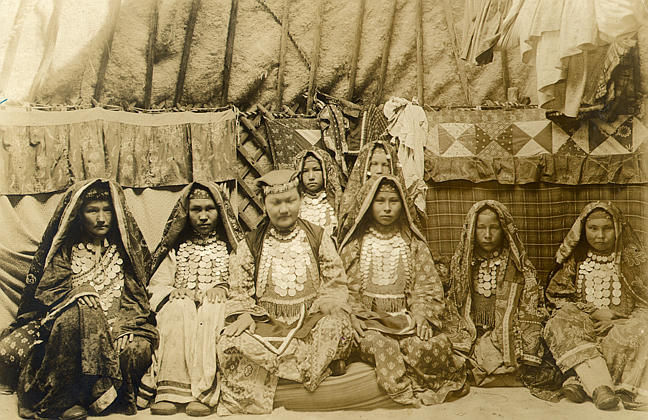
The Southern Urals and the adjacent steppes, the territories where the Bashkir ethnos was formed, have long been an important center of interaction between cultures. The archaeological diversity of the region puzzles researchers and puts the issue of the origin of the people in a long list of "mysteries of history."
Today there are three main versions of the origin of the Bashkir people. The most "archaic" - Indo-Iranian states that the main element in the formation of the ethnos were the Indo-Iranian Sako-Sarmatian, dakho-Massaget tribes of the early Iron Age (III-IV century BC), which settled in the Southern Urals. According to another, of the Finno-Ugric version, the Bashkirs are the “brothers” of the current Hungarians, because they are descended from the Magyars and the tribes of the Hungarians (in Hungary - eno). The Hungarian tradition, recorded in the 13th century, speaks in favor of the path of the Magyars from the East to Pannonia (present-day Hungary), which they did in order to master Attila’s inheritance.
Based on medieval sources in which Arab and Central Asian authors equalize the Bashkirs and Turks, a number of historians believe that these peoples are related.
According to historian G. Kuzeev, the Old Bashkir tribes (Burzyan, Usergan, Bylar, Surash, and others) were distinguished on the basis of Turkic early medieval communities in the 7th century AD and subsequently mixed with Finno-Ugric tribes and tribal groups of Sarmatian origin. In the 13th century, nomadic Kypchak tribes invaded Historical Bashkortostan, which formed the image of modern Bashkirs.
On this version of the origin of the Bashkir people are not limited. Fascinated by philology and archeology, the public figure Salavat Gallyamov, put forward the hypothesis that the ancestors of the Bashkirs once came out of ancient Mesopotamia and reached the Southern Urals through Turkmenistan. However, in the scientific community this version is considered a “fairy tale”.
Mari or Cheremis
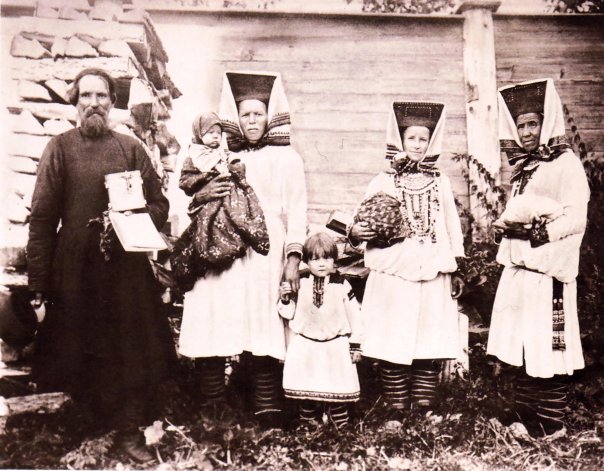
The history of the Finno-Ugric people of the Mari begins at the beginning of the first millennium BC, together with the formation in the Volga-Kamye of the so-called Ananian archaeological culture (VIII-II century BC).
Some historians identify them with semi-legendary fissagets, the ancient people who, according to Herodotus, lived near the Scythian lands. The Mari subsequently separated from them, settling from the right bank of the Volga to the honey by the mouths of Sura and Tsivil.
During the early Middle Ages, they were in close cooperation with the Gothic, Khazar tribes and the Itil Bulgaria. The Mari were annexed to Russia in 1552, after the conquest of the Kazan Khanate.
Saami
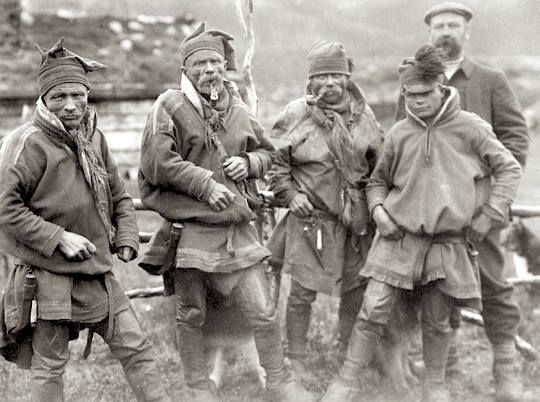
The ancestors of the northern people of the Sami - Komsa culture, came to the north in the Neolithic era, when these lands were freed from the glacier. The ethnic group of the Sami, whose name translates as the “earth” itself, dates back to the bearers of the ancient Volga culture and the pre-Finnish Caucasoid population. The second, known in the scientific world as the culture of mesh ceramics, inhabited in the II-I millennium BC a wide area from the middle Volga region to the north of Fennoscandia, including Karelia.
According to historian I. Manyukhin, mixing with the Volga tribes, they formed the ancient Samo historical community of three related cultures: the Late Kargopol in Belozerie, Kargopol and Southeastern Karelia, the lukonsaari in Eastern Finland and Western Karelia, the kjelmo and the “Arctic” in northern Karelia, Finland, Sweden, Norway and the Kola Peninsula.
Along with this, the Sami language emerges and the physical appearance of the Lapps (Russian designation of the Sami) is formed, which is inherent in these peoples even today - short stature, wide-set blue eyes and blond hair.
Probably, the first written mention of the Sámi people refers to 325 BC and is found in the ancient Greek historian Pifeus, who referred to a certain fenni (finoi) about a certain people. Subsequently, Tacitus wrote about them in the 1st century of our era, telling about the wild Fenian people living in the Lake Ladoga region. Today Saami live in Russia in the territory of the Murmansk region in the status of the indigenous population.
Peoples of Dagestan
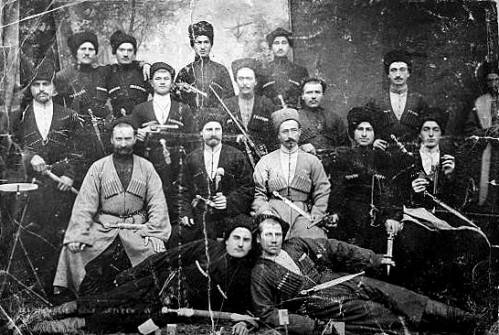
On the territory of Dagestan, where remains of human settlements dating back to the 6th millennium BC are found, many peoples can boast of their ancient origin. This applies especially to the peoples of the Caucasus type - Dargins, Laks. According to historian V. Alekseev, the Caucasion group has been formed on the same territory that it occupies even now on the basis of the oldest local population of the late Stone Age.
Vainahi
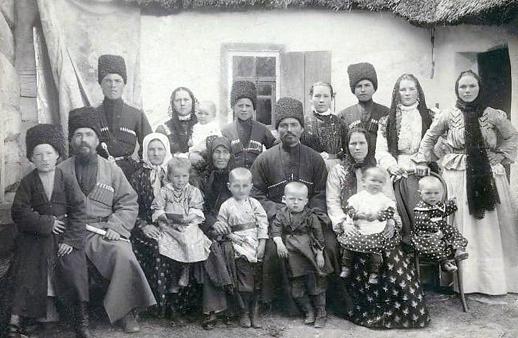
The Vainakh peoples, which include the Chechens (“Nokhchi”) and the Ingush (“Galkai”), as well as many peoples of Dagestan, belong to the ancient Caucasus anthropological type, as the Soviet anthropologist prof. Debets, "the most Caucasian of all Caucasian." Their roots should be sought in the Kura-Arak archeological culture that lived in the territory of the North Caucasus in the 4th beginning of the 3rd millennium BC, as well as in the Maikop culture that inhabited the foothills of the North Caucasus in the same period.
The references to Vainakhs in written sources are found for the first time by Strabo, who in his “Geography” mentions certain “gargarees” living in the small foothills and plains of the Central Caucasus.
In the Middle Ages, the formation of the Vainakh peoples was strongly influenced by the state of Alanya in the foothills of the North Caucasus, which fell in the XIII century under the hooves of the Mongolian cavalry.
Yukagir
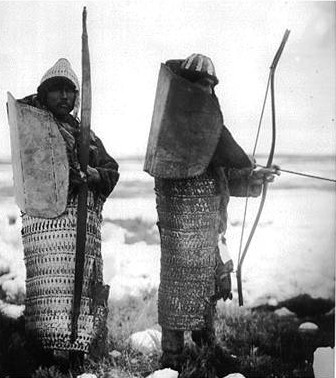
The small Siberian people of Yukagir ("people of the Mezlots" or "distant people") can be called the oldest in Russia. According to the historian A. Okladnikov, this ethnos was distinguished in the Stone Age, approximately in the VII millennium BC in the east of the Yenisei.
Anthropologists believe that this nation, genetically isolated from its closest neighbors, the Tungus, is the oldest layer of the autochthonous population of polar Siberia. The long-preserved custom of matrilocal marriage, when the husband lives in the wife’s territory after marriage, testifies to their archaic nature.
Up until the 19th century, numerous tribes of the Yukagirs (alai, Anauli, Kogime, Lavrentsy, and others) occupied a vast territory from the Lena River to the mouth of the Anadyr River. In the XIX century, their numbers began to decline significantly as a result of epidemics and civil strife. Some of the tribes were assimilated by the Yakuts, Evens and Russians. According to the 2002 census, the number of Yukagirs decreased to 1509 people.
All-Russian geographical dictation of 2016, which took place on November 20, 2016. These are questions of dictation. Try answer.
1. What is the name of an imaginary line on the surface of the globe that connects the North and South Poles by the shortest distance?
2. What is the name of the interface between warm and cold air masses in the lower part of the atmosphere?
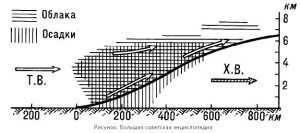
3. What is the name of a city that is located near a larger city and is economically and culturally appealing to it?
4. What is the name of the part of the river valley, flooded during flood or during floods?
5. Indicate the combination of natural zones and soils characteristic of the territory of the Central Federal District (it is enough to indicate a letter):
A) forest-steppe - krasnozemy;
B) northern taiga - brown soil;
C) mixed forests - sod-podzolic soils.
6. Select from the list the object with the lowest salinity (it is enough to indicate a letter):
A) Sivash Bay;
B) the White Sea;
C) the Gulf of Finland;
D) Black Sea.
7. What does this symbol on topographic maps mean?
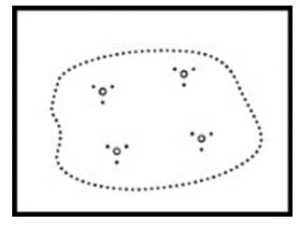
8. Arrange the mountain systems in descending order of their maximum absolute height (put down the numbers):
1) Altai; 2) the Caucasus; 3) Sikhote-Alin; 4) Khibiny.
9. The name of this people of Russia is translated as “real man”, and the outdated name is Samoyeds. The number in Russia is about 45 thousand people, most of them live along the coast of the Arctic Ocean from the Kola Peninsula to Taimyr. The main occupations are reindeer herding, fishing, and hunting. The name of the people is present in the name of two subjects of the Russian Federation. Name the people.
10. This craft is the name of a village in the Moscow region, where it originated at the beginning of the 19th century. Traditional craftwork - metal trays, painted with oil paints, usually with a pattern of a flower bouquet. Name the fishery.
11. What is the name of solid precipitation that forms on the surface of the earth and plants with a negative temperature of the soil, a low cloudy sky and a weak wind?
12. Name the natural area of Russia, where grow oak and hazel, live oriole and wild boar.
13. Locate settlements from north to south (put the letters):
A) Vologda; B) Salekhard; B) Khabarovsk; Novosibirsk city.
14. Name the archipelago, which is the most northern island territory of Russia.
15. Choose a city from the list where the sun can sometimes be seen at midnight (just enter a letter):
A) Syktyvkar; B) Murmansk; B) Omsk; D) Tomsk.
16. The Novgorod Kremlin and the Church of Peter and Paul on Sinichya Gora are included in the UNESCO World Heritage List. The distance between them in a straight line is 1.5 kilometers. What will it be on a 1:50 000 map? The answer is given in centimeters.
17. Select from the list a subject of the Russian Federation, much of which is located in the subarctic climate (it is enough to indicate a letter):
A) the Republic of Karelia;
B) the Republic of Tatarstan;
B) Tyumen region;
D) Perm region.
18. Name the tributary of the Ob River, which crosses two state borders, before entering the territory of Russia.
19. Indicate which city from the list before sunrise comes (it is enough to indicate a letter):
A) Yakutsk;
B) Okhotsk;
B) Khanty-Mansiysk;
D) Great Ustyug.
20. Name the subject of the Russian Federation in which time differs from Kamchatka by 10 hours.
21. Select from the list the river, the lower reaches of which are depicted on the satellite image (it is enough to indicate a letter):
A) Volga;
B) Lena;
B) Selenga;
D) Yenisei.
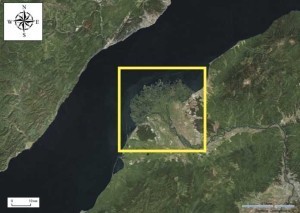
22. Name the hero-city of Russia, one of the largest ports of the Black Sea, located on the shores of Tsemesskaya Bay.
23. Name the sea washing the coast of Russia, which is characterized by the highest tides. The sea is rich in fish, seafood and hydrocarbon raw materials. Previously, it was called Kamchatka. In its southern part there are the Odessa Bay and the Terpeniya Bay.
24. Select from the list a pair of objects that are not geographically related to each other (it is enough to indicate a letter):
A) Lake Taimyr - Taimyr Peninsula;
B) Bering Island - Bering Sea;
C) the island of White - White Sea;
D) Kamchatka River - Kamchatka Peninsula.
25. Name the city, the ancient capital of North-Eastern Russia, now - the regional center on the Klyazma River, part of the tourist route "Golden Ring of Russia".
26. What natural zone does Vasily Dokuchaev write about:
“... it seems so densely occupied by some plant that nothing else seems to fit in here: it is covered with purple spots,” the anemones bloomed, or the whole meadows take on a blue azure coloring, “this is forgetting me; at other times you can meet large areas completely covered with fragrant thyme ... ”.
27. Learn the city described in the poem by Alexander Severny:
This city is in five centuries
It stands on the edge of the coast,
The border of snow, eternal ice,
The capital of rivers, forests, marshes.
It is on the centuries-old path,
No one can get around.
All ships met here
That from the White Sea to the people went.
Met Norwegians and Slavs,
I met the Dutch, the British
Varygs went to the last battle
And the Swedes are bits astern.
At the age of this river
Pomors city was built ...
28. “The great combinator moved with small steps along the mountain road leading around Mashuk to the place of the duel between Lermontov and Martynov, past sanatoriums and rest houses. Overtaken by buses and steam domes, Ostap went to the Failure ”(Ilya Ilf and Yevgeny Petrov).
The landmark of which city is the failure mentioned in the passage?
29. Name the territory described in the story of Konstantin Paustovsky:
"This region lies ... between Vladimir and Ryazan, not far from Moscow, and is one of the few surviving forest islands, the remnant of the" great belt of coniferous forests. " In ... the region you can see forest lakes with dark water, vast swamps covered with alder and aspen ".
30. Name the expedition held in 1937-1938, in which the participation depicted on the stamp depicted by Ivan Papanin, Yevgeny Fyodorov, Ernst Krenkel and Peter Shirshov.
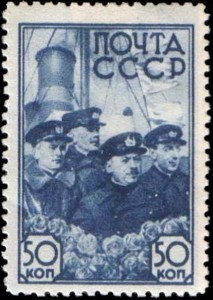
1. Meridian. 2. Atmospheric front (front of occlusion). 3. City - satellite, 4. Poyma, 5. V, 6. V, 7. Shrub, 8) 2.1, 3, 4. 9). Nenets, 10. Zhostovo painting, 11. Frost 12. Mixed and deciduous forests. 13. B, A, G, V. 14 . Franz Josef Land. 15. B, 16. 3 cm., 17. C, 18. Irtysh, 19. B, 20. Kaliningrad region, 21. C, 22. Novorossiysk, 23. Okhotsk. 24. B, 25. Vladimir, 26. Steppe, 27. Arkhangelsk, 28. Pyatigorsk, 29. Meshchera, 30. North Pole 1.
|
Leave a comment, thanks! Comments on "Geographic dictation 2016. Questions."
|
